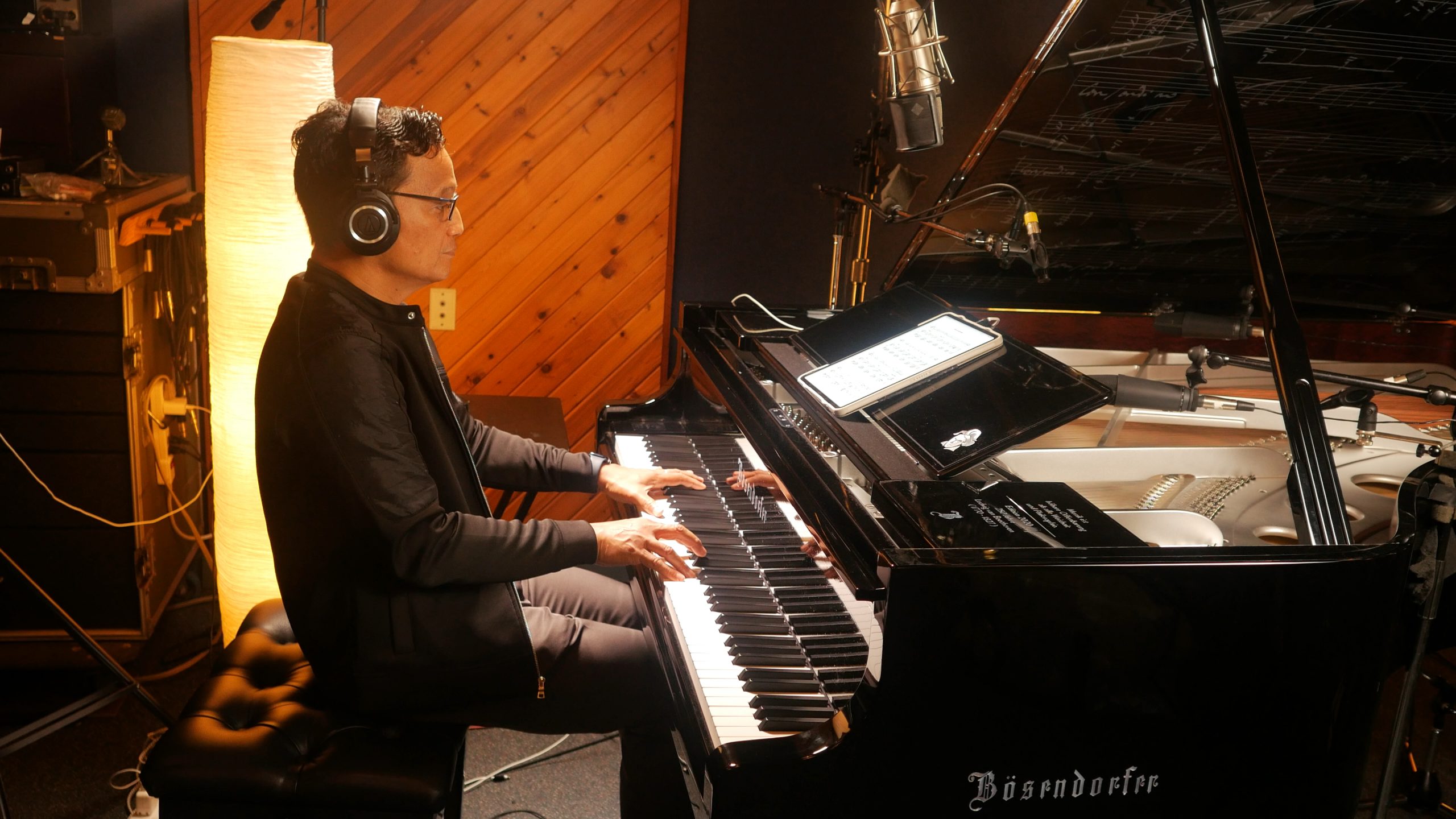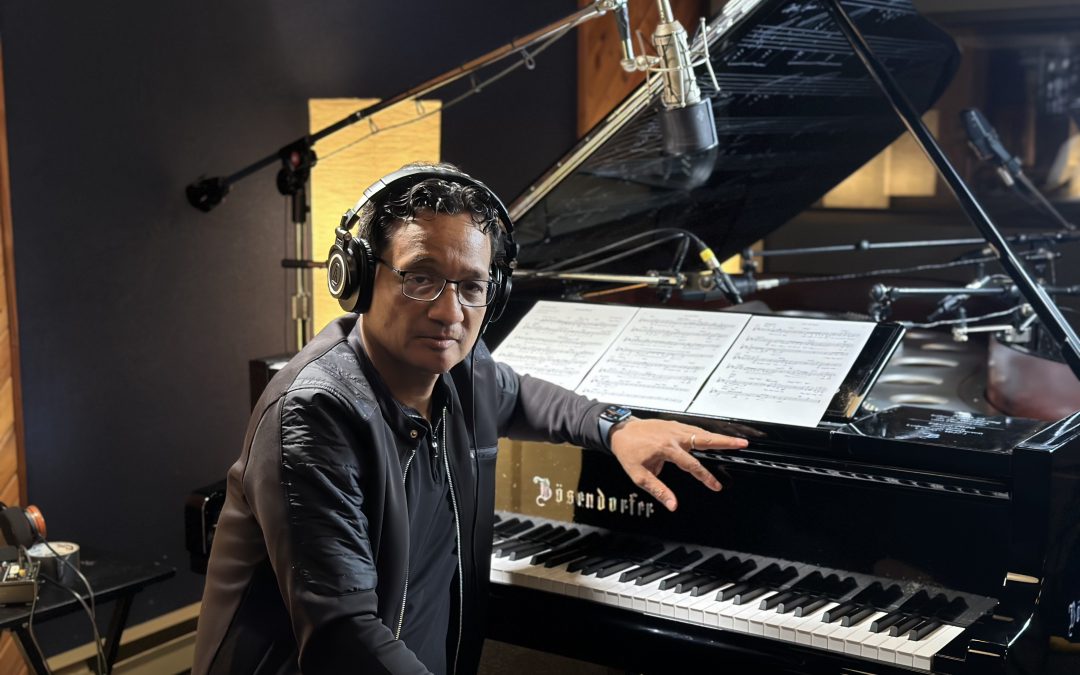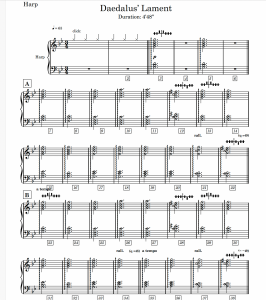In this Dorico Showcase, we are thrilled to feature Juno and multi-Emmy-winning pianist, composer, and producer D.D. Jackson. In addition to his impressive musical career, D.D. Jackson currently teaches at NYU, the Honors College and also Jay-Z’s Roc Nation school at LIU Brooklyn, and the Feirstein Graduate School of Cinema at Brooklyn College. His latest album, D.D. Jackson: Poetry Project, released on September 6th, 2024, showcases the composer’s unique ability to blend jazz, orchestral, and vocal arrangements. Inspired by poems curated by Canada’s former Poet Laureate George Elliott Clarke, the album represents a fusion of literary art and music, brought to life through D.D.’s mastery of composition. In this interview, D.D. shares how Dorico played an essential role in his creative process. He reveals how he used Dorico to compose, arrange, and orchestrate the album’s intricate pieces, even employing the software’s iPad version for on-the-go adjustments during a particularly down-to-the-wire recording session. Read on to discover more.
AN: Hi D.D., it’s a pleasure to talk to you! Could you share some information about the Poetry Project and the inspiration behind it?
D.D.: It’s really the most ambitious thing I’ve ever done among my 14 albums as leader or co-leader. It originally began as a project in which Canada’s former Poet Laureate George Elliott Clarke commissioned me during the pandemic over the course of over a year to create original songs based on the lyrics of a diversity of Canadian poets he curated (I’m based in the greater NYC area but am proudly Canadian-born!). After I subsequently received a Canada Council grant, I took this concept into the recording studio and created this Poetry Project album (available here with a 32-page poetry/liner notes booklet, and also on streaming everywhere). The recording includes my own arrangements of these poems set to 13 songs, with everything from: string quartet, to various jazz combinations – with myself on not only a $200,000, exquisite Bösendorfer piano as a Bösendorfer Artist, but on Wurlitzer, Rhodes, and Hammond organ – plus an array of artists ranging from Snarky Puppy’s Larnell Lewis on drums, Juno-winning vocalists Laila Biali and Sammy Jackson, to the Czech National Symphony Orchestra. I even make my “singing debut” on two tracks that particularly affected me: “The Father’s Dream” and the orchestral piece “Daedalus’ Lament”, which concludes the album. So it feels like a good summary of the many avenues of expression I’ve tried to explore thus far in my career, though I’m hopeful and perhaps optimistic that it all still ends up coming out sounding somehow like “me”!

AN: Can you describe the role that Dorico played in the composition and orchestration process for your Poetry Project album? Were there specific features of Dorico that you found particularly useful?
D.D.: Dorico Pro played an absolutely critical role in the process. After having used your delightful program since version 2 (I even taught a college course centered around it a couple of years ago) the ease and speed with which I can work with it was extremely critical, due to the large number of scores and parts I needed to generate, sometimes “on the fly”, and the many iterations these pieces went through over the time, which Dorico handled with tremendous aplomb.
To start with, George originally requested that the initial song commissions be presented in the format of an “official”, nicely-printed piano/vocal score that I would print using tabloid paper (two score pages/tabloid paper in landscape format), printed as a booklet, and signed by myself and the poet, on which he would add on the cover a special poem dedication, commenting on the particular song, etc., which of course Dorico handled beautifully, including the actual printing/booklet assembly.
However, my actual composition of the song typically began in Logic Pro as a mock-up, and so I greatly appreciate Dorico Pro’s ability to quickly work with my MIDI exports so easily. My basic approach was to separate the left and right piano hands onto two separate Logic tracks and line up the start/end points of each region. But that was essentially it – the rest was handled on Dorico Pro’s input. I appreciate the fact that I could set in Dorico a default quantization based upon the shortest value note of the MIDI data, but then easily select groups of notes and re-quantize on the fly after import. Dorico’s ability to quickly re-assign voices on a given piano staff to voice up or down meant that voice management for piano could be edited quite efficiently until I got the look I wanted. Most critically, I was quite fond of taking an actual bounce of my Logic session as audio, attaching it quickly to a static video file (using any video editing program such as iMovie or Final Cut Pro), and then importing the video file also to my Dorico session, attaching it right to the flow in Setup Mode. The result was that I could use the video fader in Dorico’s mixer to exactly sync the reference bounced track with the imported Logic Pro MIDI data I was working on in Dorico to make sure everything matched up exactly.
The main specific “feature” for me, though, at the end of the day, was simply speed and ease-of-use. After having come along from the days of Encore followed by Sibelius, I never dreamed that there could be a program so musician-centered which had the feeling of flexibility and the effortlessness I’ve otherwise only found when using a DAW – but somehow Dorico Pro has done it. I particularly love the ability to shorten/lengthen notes on the fly and move them to the left or right, to a higher or lower stem and so on, much as I would in a DAW’s piano roll. I never thought I’d say this about any notation program, but it really makes Dorico Pro simply fun to use, as an actual creative tool.
After having come along from the days of Encore followed by Sibelius, I never dreamed that there could be a program so musician-centered which had the feeling of flexibility and the effortlessness I’ve otherwise only found when using a DAW – but somehow Dorico Pro has done it. I particularly love the ability to shorten/lengthen notes on the fly and move them to the left or right, to a higher or lower stem and so on, much as I would in a DAW’s Piano Roll. I never thought I’d say this about any notation program, but it really makes Dorico Pro simply fun to use, as an actual creative tool.

AN: The Poetry Project album began with a collaboration with George Elliott Clarke, who curated poems from various Canadian poets. Could you tell us more about how you chose the poems from these collections and the process of transforming them into musical pieces?
D.D.: George chose 11 separate poets for the album among the 13 songs (including 2 songs based on poems he wrote himself). All songs were initially commissioned of me by George (with the exception of one song commissioned by fellow poet on the album Giovanna Riccio). For each poet he would graciously curate and then give me a selection of their work to choose from, sometimes slightly nudging me in one direction or another but ultimately letting me choose which poem I thought was best set to song. This afforded me some latitude to focus on only those poems for which the addition of music could really add a new spin or direction to the material. So it was always an exciting challenge to take my cues for a given poem as far as how to treat it from not only the implications of the tone and content of the poem, but it’s structure.
“So, Say I”, for example, originally was set as a sort of stream of conscious run-on sentence, by the brilliant Canadian poet Micheline Maylor, and so it immediately brought to mind fast-paced bebop, especially when I managed to find some video of her reciting the poem in beatnik poetry style – so that track ends up leaning strongly in that direction. “Alternating Current” was translated from a Chinese poem by Yin Xiaoyuan, the only non-Canadian poet on the album, and is an abstract medication on gender identity, with lots of avant garde imagery. So the song includes a freely improvised and enjoyably “out there” trio between myself on piano, Grammy-nominated violinist Curtis Stewart, and the Canadian singer Yoon Sun Choi, before evolving into an irregular groove-based rhythm, culminating in a crazy solo over this groove by Curtis, with myself switching to Wurlitzer electric piano.
But then there are also other poems on the album that had more formal – and even rhyming! – structures, which allowed for more accessible pieces such as the first single I released, “Mavety Street” (poem by Canadian poet Bruce Meyer), and sung by the inimitable Laila Biali; or “A Pavane for Georgie” (lyrics by Giovanna Riccio and sung by Canadian singer Sammy Jackson).
So there’s really an incredibly varied array of approaches/styles represented, but they all first came out of the poems, for sure.
Check out the official video for “Mavety Street”, the latest single from D.D. Jackson: Poetry Project, and the 2nd released video, “A Pavane for Georgie”:
ΑΝ: You mentioned using Dorico for iPad for a last-minute transposition during your recording session with one of the tunes. How did the iPad version of Dorico support you in this situation, and how does its functionality compare to the desktop version when working under tight deadlines?
D.D.: It was with the song “A Pavane for Georgie”. We were experimenting with different keys and I mistakenly had transposed something incorrectly on Dorico Pro using my Mac Studio setup I’d brought with me, back at the hotel. With the clock ticking I realized I had my iPad with me and could open the file (synced to my iCloud library thankfully) directly in Dorico for iPad. Amazing that its functionality is so similar to the full-fledged desktop version, and that files “just work”. I made the change, printed a part for the singer and read my own part directly from the iPad, and the session kept rolling!
AN: Were there any unique challenges you faced when composing and arranging for Poetry Project, and how did Dorico help you overcome them?
D.D.: One of the main challenges was the need for sometimes quick revisions. All of the pieces, for example, were originally written with my vocal range in mind, and from mockups I’d originally done in Logic, which as I’ve described became an elegant piano/vocal score version for George’s needs. But Dorico had the flexibility to allow me to re-purpose that original version in many cases quite significantly, transposing to the given singer’s vocal range, adding additional instrumentation, changing the look/feel to something in certain cases more suitable to jazz – I always love the Petaluma font despite all the new fonts Dorico has since added! – and doing multiple parts with many changes whenever needed, and always fast, fast, fast!
AN: Working with Musiversal.com’s Czech National Symphony Orchestra sounds like a remarkable experience. How did Dorico facilitate the orchestration process for this collaboration?
D.D.: For projects such as my orchestral piece “Daedalus’ Lament”, there were too many useful features to name, but here’s one example: While that particular piece began again as a Logic mockup, I was able to easily flesh out the instrumentation within Dorico Pro itself after importing the Logic midi data (as in the above) and again syncing a bounced version to video I could use directly within Dorico as an audio reference. To this end, I greatly appreciate Dorico Pro’s integration with NotePerformer 4, which I consider an essential third party Dorico add-on given how powerful it is for such low cost. I’m sure many know about NotePerformer 4, but for those who don’t, it essentially intelligently and automatically creates expressive playback by interpreting the actual music notation/articulations and comparing it to how other such symbols might typically be interpreted in similar circumstances in other scores with extremely expressive playback. New to Note Performer 4 is the ability to use higher-level sample libraries to achieve this playback, and so since I already owned the the Spitfire BBC Pro Symphony Orchestra library, I was able to achieve extremely expressive and accurate playback of my Dorico Pro score with zero additional tweaking of the underlying MIDI data within Dorico. The ability to have multiple instruments for a player (such as with percussion) which I could easily assign when in galley view and which the part version would then elegantly condense complete with indications of when to switch, etc. is now also a longstanding feature that makes such work effortless, and the parts beautiful to look at and read for the players.
AN: What do you hope listeners will take away from Poetry Project, and how do you see this album fitting into the broader context of your musical career?
D.D.: I feel like it’s sort of a culminating project, reflecting all of the experiences I’ve now gained over the years, while also hopefully hinting at what’s to come – in fact, I’ve already written ten new songs that may very well become the beginnings of “Vol. II”! I think in the diversity of the expression and the sheer scope – it really took 3 years to make – people will hopefully walk away with a good sense of my overall musical perspective, which I might characterize as “diverse and open-minded”, and due to the range of emotions/approaches, artists, and poems represented on the recording, there should be something on the album that everyone will enjoy!
AN: Are there any upcoming projects or new directions you’re exploring that you’d like to share with us? How do you envision continuing to evolve your work in the future?
D.D.: As mentioned, there’s a “part 2” in the works but we’ll see if it’s the next project. I’m also eager to take this music, albeit in a more compressed form, on the road, but will start with a release party weekend event we have planned in Toronto: a solo piano concert with guest vocalist Yoon Sun Choi (from the album) on Fri.Dec. 6th at the Redwood Theatre, a release party poetry and performance event at the same venue on Sat. Dec. 7th, and then a special talk I’m giving (also in Toronto), sponsored by Peter Thornton.
AN: Thank you for taking the time to talk to us D.D. and sharing your work with our audience.
D.D.: Thank you! The album is again available on streaming but I highly encourage people to consider getting the digital album version (or the physical CD) from https://ddjackson.bandcamp.com so they can appreciate the beautiful 32-page full color booklet that it comes with, including a re-print of all the poems that were the basis for the songs on the recording, and two sets of liner notes – one by my hometown jazz critic from Ottawa, James Hale, and the other by the original song commissioner George Elliott Clarke himself, not to mention photography by my daughter Sun. There’s also lots of other offers available, including one with all of the original audio and video mockups of all 13 songs and some scores from the session.


